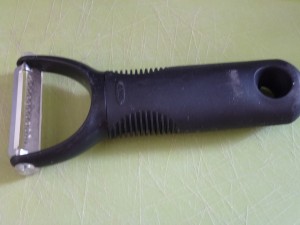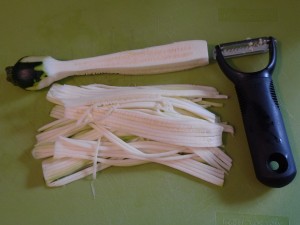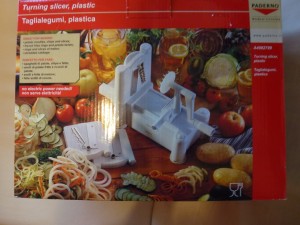For the family/person that is cutting back or totally eliminating gluten, pasta is often a sad loss… At least it is for me. One alternative is to cook pasta for those people that can eat it and let those that can’t eat pasta they can use some of the new substitute pasta like quinoa, rice, spelt, etc. Often if you look at the label though, these are not necessarily fully gluten free. Here’s another neat choice. Vegetable ‘pasta’.
For most kids getting more vegetables into their diet is a bit of a trial. This is one way that they might even like vegetables and maybe even ask you to make them.
Most typically this type of ‘pasta’ is used in raw cooking. There is no reason whatsoever that you can’t steam the vegetables before you put a sauce on them or just put a warm/hot sauce on them before you serve it. The pasta is usually so light that it takes very little effort to warm and soften it.
The most common pasta vegetable is the versatile zucchini. It is mild in taste and takes on the flavours of sauce well and holds its shape fairly well. It is usually of reasonable size and is fairly straight.
But don’t stop there. Experiment! Most of the root vegetables lend themselves really well to this application. They are usually served raw to lightly cooked so most of the nutrients are retained. Carrots full of carotene. Parsnips make light and fluffy noodles great for Asian soups and are great for the brain. Sweet potatoes come in many colors. Beets provide a great contrast. There are so many varieties of squashes! Not just the spaghetti squash.
Just imagine a pasta dish served with one or more of all those wonderful vegetables.
After taking my raw food class, I didn’t feel that it was time to commit to buying a spiralizer even though I really enjoyed raw pasta. It was on the list of tools but there were several even more expensive ones on my want list.
If you are really adept with your knife skills you can probably julienne vegetables really easily. You can also use a regular vegetable peeler to cut nice long strings of vegetable, again a bit tricky. Hand graters will give short thin pieces of vegetables. A food processor, depending on your blade can grate or make slightly longer pieces (like the French fry blade) fairly quickly, but the pieces are again fairly short. But I was really looking for something like spaghetti or fettucini.
I was wondering around in one of our local kitchen supply stores and I found this wonderful tool. Because it was under $10 I decided to go for it.
Depending on what kind of pasta dish I am making, I usually start by peeling the vegetable and save the peel for compost. I know that a lot of nutrients are in the peel, but the darker color isn’t always so pretty and the peel tends to be a little tougher.
I will cut off one end so that it is flat and then leave the end that was attached to the plant as a handle. Then you just start cutting long strips away from you to the end. I have found it best to rotate the vegetable ¼ each time so eventually you have a square core. To have really nice pasta I usually stop when I reach the inner part where there are seeds. The core that is left, I cut up and use in my sauce or for raw cookies or other baking
I was taking a raw food class several years ago and we got to use a wonderful tool called a spiralizer. There are several varieties and brands available. But essentially they are like an old-fashioned apple peeler but modified to only peeling varying widths of ribbon of vegetable at a time. It is an incredibly fun tool because in very short order you get a very long spiral of vegetable ‘pasta’.
In order to best use the spiralizer, you do need to have fairly straight vegetables. But if you are buying vegetables from a store, they tend to be pretty esthetically pleasing – meaning straight.
Depending on what kind of pasta dish I am making, I usually start by peeling the vegetable and save the peel for compost. I know that a lot of nutrients are in the peel, but the darker color isn’t always so pretty and the peel tends to be a little tougher.
I will cut off one end so that it is flat and then put the vegetable into the claw with the cut end touching the blade. Then put pressure on the track so that the vegetable stays firmly against the blade while you rotate the handle.
In order to actually use the pasta I usually end up using scissors to cut the pasta into manageable lengths.
Once you have cut the whole vegetable you will end up with a small core which you should cut up and use in whatever sauce you are making or save them for your pet or use them in baking




Recent Comments